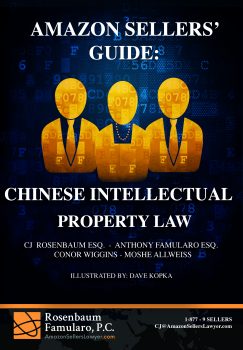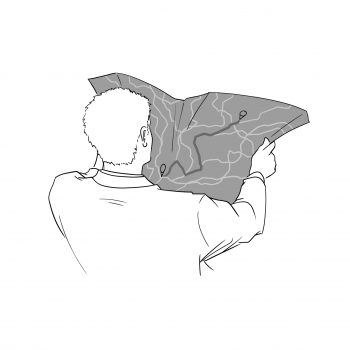
Amazon Sellers’ Guide: Chinese IP Law
By: CJ Rosenbaum Esq., Anthony Famularo Esq., Conor Wiggins, and Moshe Allweis
Chapter One:
Then and Now: A Brief History of Intellectual Property in China ……….. 1
China’s Historical and Cultural Interpretation of Intellectual Property Rights ……….. 3
Realities of Chinese Intellectual Property Today ……….. 8
Chapter 1: Then and Now: A Brief History of Intellectual Property in China
 Anyone interested in understanding intellectual property in China need only do a quick Google search to realize that the Chinese intellectual property landscape is tumultuous.
Anyone interested in understanding intellectual property in China need only do a quick Google search to realize that the Chinese intellectual property landscape is tumultuous.
President Trump’s 2018 tariffs called for a “big fine”[1] over Chinese-treatment of U.S. intellectual property law and for an end to the “greatest transfer of wealth in history,”[2] at over $600 billion a year in lost intellectual property profits[3]. Chinese-handling of American intellectual property seems to be one of the few bipartisan issues remaining in the U.S. However, this view of Chinese intellectual property, from a purely-American lens gives China more undue criticism than the country deserves.
The Chinese marketplace is booming and ripe for investment. The breakneck development of e-commerce companies like Amazon, Alibaba, and eBay have provided the keys to the global marketplace not just for corporations, but also individual Sellers to market their products all over the world. As such, it is absolutely paramount that Sellers understand their intellectual property rights in China.
The seeming lawlessness of intellectual property in China has often garnered it the title of being a “wild west.” However, China’s intellectual property law is just one small component of China’s ancient and storied history. While China continues to update, improve, and standardize their intellectual property rights, it is important for Sellers to understand that with a history as long and as notable as China’s there are bound to be cultural and societal differences that influence exactly what intellectual property means to the Chinese people. Therefore, before delving into the specifics of registering for and protecting intellectual property rights in China, we must first understand where intellectual property rights have come from in China. China’s long-standing history of intellectual property can be divided into three distinct phases: Ancient China, Maoist China, and Post-Mao China.[4]
(I). China’s Historical and Cultural Interpretation of Intellectual Property Rights
(A) Ancient China
 Intellectual Property is nothing new in China. China’s first copyright regulation was announced by the Emperor in 835 A.D. This original copyright regulation prohibited artistic works portraying natural events from being created since it was understood at the time that the Emperor was the link between the people and occurrences in the natural world. Trademarks began to develop during the Tang Dynasty (618-907 A.D.) when traders began using marks and logs to distinguish their goods from others.[5] This later flourished into a system during the Ming Dynasty (1368-1644 A.D.) which allowed manufacturers to register trademarks with other guilds.[6]
Intellectual Property is nothing new in China. China’s first copyright regulation was announced by the Emperor in 835 A.D. This original copyright regulation prohibited artistic works portraying natural events from being created since it was understood at the time that the Emperor was the link between the people and occurrences in the natural world. Trademarks began to develop during the Tang Dynasty (618-907 A.D.) when traders began using marks and logs to distinguish their goods from others.[5] This later flourished into a system during the Ming Dynasty (1368-1644 A.D.) which allowed manufacturers to register trademarks with other guilds.[6]
The ideals of Confucianism are often noted as a counter to this early intellectual property development in China. This philosophy valued the importance of the community over the individual, and it is well known that Confucius had a disdain for commerce and working solely for profit.[7] In complete opposition to this philosophy, Western capitalism and the utilitarian interpretation of intellectual property rights grant “limited monopolies”[8] to those who possess them. In response, others have argued that Confucianism protects individual rights differently from the West by creating a culture where personal Development and innovation is extremely important but for the
good of the community rather than the individual.[9]
(B) Maoist China
It is widely recognized that intellectual property ceased to exist in Maoist China. The Cultural Revolution brought about by Mao and his communist regime oversaw the complete elimination of the concepts of both physical and intellectual property. The copyright laws of the 1950’s in China actually prevented Chinese publishers from paying or seeking permission from foreign rights-holders to use their works unless they were from another socialist nation.[10]
(C) Post-Maoist China
Shortly after Mao Zedong’s death, the Chinese intellectual property landscape again began to change drastically. In 1979, China signed a bilateral agreement with the United States recognizing and allowing for the protection of American copyrights, trademarks, and patents, in China.[11] Throughout the 1980’s, China became party to many international bodies and treaties such as the World Intellectual Property Organization, the Berne Convention, the Paris Convention, and the Patent Cooperation Treaty.[12]
In 2000, the U.S. China Relations Act’s signing normalized trade relations between the U.S. and China and became a permanent installation.[13]
Today, China protects domestic copyrights, trademarks, and patents from the State Intellectual Property Office (SIPO) and the Chinese Trademark Office (CTMO). Under the auspices of these new departments, the People’s Court of China received, accepted, and closed 766,101 intellectual property right cases of first impression from 1985-2016.[14] China is outpacing the entire world in both patent and trademark registration. In fact, in 2016, Chinese companies and individuals lead the globe in intellectual property protection registration: 6,997,600 trademarks and 3,127,900 patents were filed.[15] By comparison, and in a very distant second, the United States registered 517,297 trademarks and 589,410 patents.[16]
With all of this historical development in mind, it should be said that instead of criticizing China for conducting intellectual property dispute resolution differently, it is more important to understand the differences in how the U.S. and China handle these issues in order to work side by side. From copyright edicts instituted by the Emperor, reinterpretations by the hand of Confucianism, total bans by Mao, and a reunion through international agreements, China has tackled intellectual property issues for thousands of years.
CJ’s Side Note: Like everything in the news or on the internet, you need to take it all with a grain of salt. Yes, China has their fair share of intellectual property problems, but all hope is not lost. By having a better understanding of the history of intellectual property law in China, a nation of inventors and innovators, it seems reasonable to assume that intellectual property protections will continue to improve. There has been a positive trend in the People’s Court for improved rights and protections for injured parties that have had their intellectual property stolen.
(II). Realities of Chinese Intellectual Property Today
Despite China’s long history with intellectual property, it is impossible to deny that protecting intellectual property rights in China today is a real issue. The country remains on the 2017 “priority watch list” of the U.S. Trade Representatives Office’s annual “shame list” of countries with poor intellectual property protections.[17] As of November 8, 2017, over 1,600 American intellectual property rights infringements have been uncovered, with countless others yet to be discovered.[18]
The question is how does a Seller interested in diving into the Chinese market through global e-commerce ensure that their intellectual property rights are protected? The answer to that question is multi-faceted and at times highly complex.
The first step of this process is to BE AWARE THAT YOU NEED PROTECTION.
[1] Jeff Mason, Exclusive: Trump Considers Big ‘Fine’ Over China Intellectual Property Theft, Reuters (Jan. 17, 2018), https://www.reuters.com/article/us-usa-trump-trade-exclusive/exclusive-trump-considers-big-fine-over-china-intellectual-property-theft-idUSKBN1F62SR.
[2] Dennis C. Blair and Keith Alexander, China’s Intellectual Property Theft Must Stop, NY Times (Aug. 15, 2017), https://www.nytimes.com/2017/08/15/opinion/china-us-intellectual-property-trump.html.
[3] Id.
[4] Staff Editor, China’s Long and Tortured History When It Comes To Intellectual Property Laws, JIPEL Blog – NYU Journal of Intellectual Property & Entertainment Law (Feb. 4, 2014), https://blog.jipel.law.nyu.edu/2014/02/chinas-long-and-tortured-history-when-it-comes-to-intellectual-property-laws/.
[5] Hamideh Ramjerdi & Anthony D’Amato, The Intellectual Property Rights Laws of The People’s Republic of China, 21 N.C.J. Int’l L. & Com. Reg. 169, 172 (1995).
[6] Charles Baum, Trade Sanctions and the Rule of Law: Lessons from China, Stan. J. E. Asian Aff. 46, 51 (2001), http://www.stanford.edu/group/sjeaa/journal/china4.pdf.
[7] Wang Lewei, The Chinese Traditions Inimical to Patent Law, 14 NW. J. Int’l & Bus. 15, 36-56(1993).
[8] China’s Long and Tortured History, JIPEL Blog (Feb. 4, 2014), https://blog.jipel.law.nyu.edu/2014/02/chinas-long-and-tortured-history-when-it-comes-to-intellectual-property-laws/.
[9] Wei Shei, Cultural Perplexity in Intellectual Property: Is Stealing a Book an Elegant Offense, 32 N.C.J. Int’l L. & Com. Reg. 1 (2006); quoting John R. Allison & Lianlian Lin, The Evolution of Chinese Attitudes toward Property Rights Invention and Discovery, 20 U. Pa. J. Int’l Econ. L. 735, 744 (1999).
[10] China’s Long and Tortured History, JIPEL Blog (Feb. 4, 2014), https://blog.jipel.law.nyu.edu/2014/02/chinas-long-and-tortured-history-when-it-comes-to-intellectual-property-laws/.
[11] Qiao Dexi A Survey Of Intellectual Property Issues In China-U.S. Trade Negotiations Under The Special 301 Provisions, Pacific Rim Law & Policy Journal Vol. 2 No. 2, 259, 260.
[12] China Laws (302 texts), WIPO World Intellectual Property Organization (last visited Jun. 18, 2018), http://www.wipo.int/wipolex/en/profile.jsp?code=cn.
[13] U.S. Relations With China 1949-2018, cfr.org (last visited Jun. 18, 2018), https://www.cfr.org/timeline/us-relations-china.
[14] Supreme People’s Court, China’s Intellectual Property Judicial Protection Program (2016-2020), law-lib.com (last visited Jun. 18, 2018), http://www.law-lib.com/law/law_view.asp?id=566119.
[15] WIPO World Intellectual Property Organization, China Tops Patent, Trademark, Design Filings in 2016 (Dec. 6, 2017), http://www.wipo.int/pressroom/en/articles/2017/article_0013.html.
[16] Id.
[17] Office of the United States Trade Representative, 2017 Special 301 Report (last visited Mar. 25, 2017), https://ustr.gov/sites/default/files/301/2017%20Special%20301%20Report%20FINAL.PDF.
[18] China Uncovers Almost 1,600 U.S.-Related Intellectual Property Infringements This Year, Reuters (Nov. 8, 2017), https://www.reuters.com/article/us-china-u-s-intellectual-property/china-uncovers-almost-1600-u-s-related-intellectual-property-infringements-this-year-idUSKBN1D90A0.
